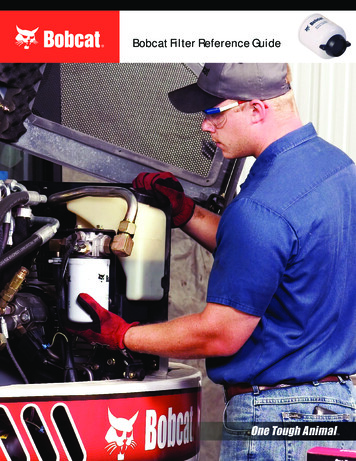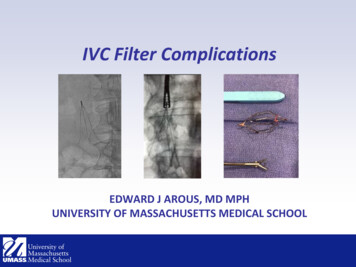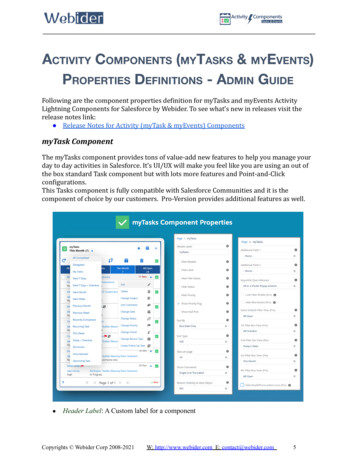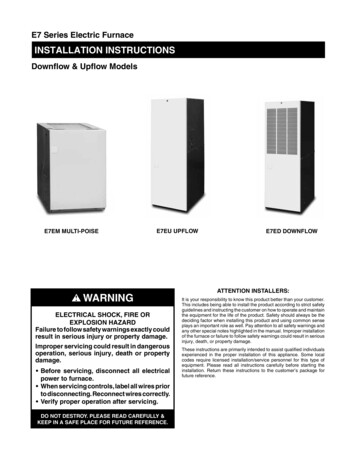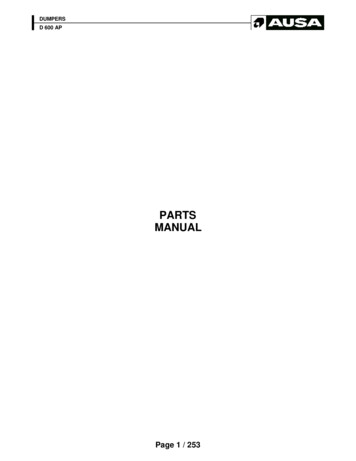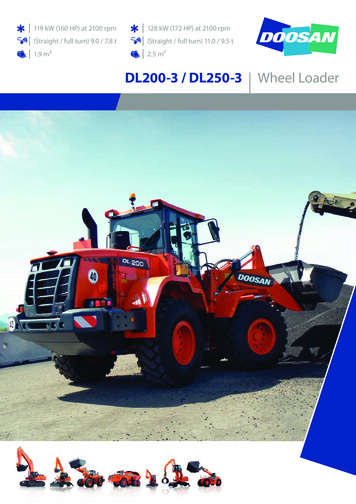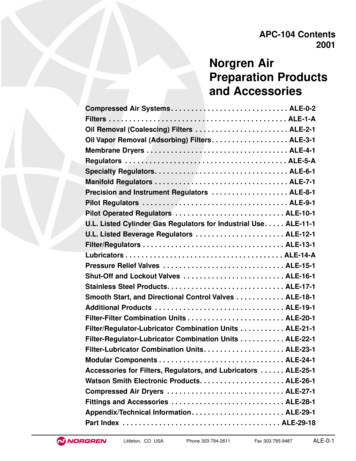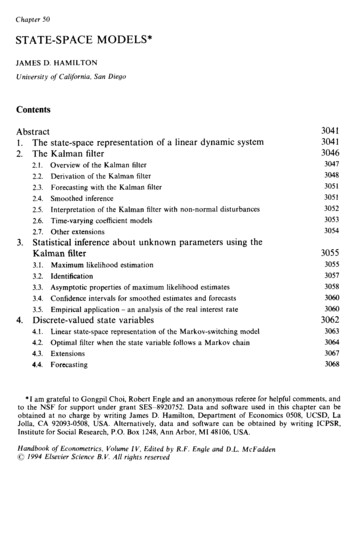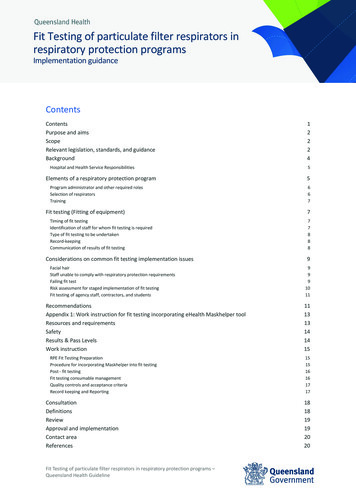
Transcription
Fit Testing of particulate filter respirators inrespiratory protection programsImplementation guidanceContentsContentsPurpose and aimsScopeRelevant legislation, standards, and guidanceBackgroundHospital and Health Service ResponsibilitiesElements of a respiratory protection programProgram administrator and other required rolesSelection of respiratorsTrainingFit testing (Fitting of equipment)Timing of fit testingIdentification of staff for whom fit testing is requiredType of fit testing to be undertakenRecord-keepingCommunication of results of fit testingConsiderations on common fit testing implementation issuesFacial hairStaff unable to comply with respiratory protection requirementsFailing fit testRisk assessment for staged implementation of fit testingFit testing of agency staff, contractors, and studentsRecommendationsAppendix 1: Work instruction for fit testing incorporating eHealth Maskhelper toolResources and requirementsSafetyResults & Pass LevelsWork instructionRPE Fit Testing PreparationProcedure for incorporating Maskhelper into fit testingPost - fit testingFit testing consumable managementQuality controls and acceptance criteriaRecord keeping and ReportingConsultationDefinitionsReviewApproval and implementationContact areaReferencesFit Testing of particulate filter respirators in respiratory protection programs –Queensland Health 6161717181819192020
Additional resources20Purpose and aimsThe Fit Testing of Particulate Filtration Respirators (PFR or P2/N95 respirators) in respiratory protectionprograms Guidance Document (Fit Testing Document) has been developed to provide guidance andrecommendations for decision-makers and healthcare workers (HCWs) in Queensland. The purpose ofthe document is to support the safe and practical implementation of fit testing as part of respiratoryprotection programs.The document aims to: Acknowledge the primacy of health, safety, and wellbeing of all workers at work, and all otherpeople who might be affected by the work (i.e. our patients, visitors, and community) Highlight the practical considerations for implementation of large-scale fit testing programs Provide guidance on a prioritisation approach to support optimal allocation of effort andresources Provide guidance on some of the complex issues and risks associated with risk basedrespiratory protection programsScopeThis guidance document provides information for all Queensland Health Hospital and Health Service(HHS) employees and all organisations and individuals acting as its agents (including visiting MedicalOfficers and other partners, contractors, consultants, students and volunteers) and all Queenslandlicensed private health facilities. The information in this guidance document may also be applied byother health and care organisations and services such as primary care and residential care. It isintended to inform local policies and to support local decision-making using a risk managementframework.Guidance on general risk and incident management is presented in Queensland Health’s Health, safetyand wellbeing risk management standard QH-IMP-401-3:2020.Relevant legislation, standards, and guidanceThis guidance document should be read in conjunction with the following:Work Health and Safety Act 2011 (Qld)Provides a consistent framework to secure thehealth and safety of workers and workplaces.Workers and other persons at the workplace(including patients, visitors etc.) must also takereasonable care for their own health and safety;and care that their conducts, acts or omissionsdoes not adversely affect the health and safetyof others.Fit Testing of particulate filter respirators in respiratory protection programs v2.0 25 January 2022PPE Working Group of the CRGPRINTED COPIES ARE UNCONTROLLEDPage 2
Work Health and Safety Regulation 2011 (Qld)Division 5, Section 44 (3) of the Regulationdescribes how to prevent or minimise risk at theworkplace and includes provisions specificallyregarding PPE suitability, size, fit, maintenance,hygiene, and use.Australian/New Zealand StandardsAS/NZS 1715:2009 - Selection, use andmaintenance of respiratory protectiveequipmentAS/NZS 1716:2012 - Respiratory protectivedevicesAS 4381:2015 - Single-use face masks for use inhealthcareA/NZS 2243.3 – Safety in Laboratories.International StandardISO 16975-3 Respiratory protective devices,selection use and maintenance- Part 3 Fit testingprocedures First Edition 2017-09Australian Guidelines for the Prevention &Control of Infection in Healthcare (2019)Recommends that where there is a highprobability of airborne transmission due to thenature of the infectious agent or procedure thena correctly fitted P2/N95 respirator should bewornNational Safety and Quality Health ServiceStandards: Standard 3 - Preventing andControlling InfectionsStandard 3 requires that leaders of healthservice organisations develop, implement, andmonitor systems to prevent, manage and controlinfections.Health, safety and wellbeing risk managementStandard, QH-IMP-401-3:2018This Queensland Health Standard establishes therequirements for managing work health andsafety (WHS) hazards and risks.A Guide to Buying P2, or Equivalent, Respiratorsfor use in the Australian & New Zealand WorkEnvironmentThis document, produced by the AustralianInstitute of Occupational Health, providesdetailed information to be used in the selectionof respiratory protection equipment.Infection prevention and control guidelines forthe management of COVID-19 in healthcaresettingsQueensland Health’s overarching guidance forinfection prevention and control of COVID-19 inhealthcare settings.Personal protective equipment in healthcaredelivery, community health and in-home caresettings, correctional servicesandPersonal protective equipment in residentialaged care and disability accommodation servicesQueensland Health’s guidance to the PPErequirements during different levels risk ofunanticipated COVID-19 infection in thecommunity.Fit Testing of particulate filter respirators in respiratory protection programs v2.0 25 January 2022PPE Working Group of the CRGPRINTED COPIES ARE UNCONTROLLEDPage 3
Minimising the risk of infectious respiratorydisease transmission in the context of COVID-19:the hierarchy of controlsThis Australian Government Department ofHealth document outlines how to use thehierarchy of controls to manage the risk ofCOVID-19 transmission.The use of face masks and respirators in thecontext of COVID-19This guidance, produced by the Infection ControlExpert Group of the Australian Health PrincipalProtection Committee, includes generalconsiderations on the use of masks andrespirators and recommendations for their usein the context of COVID-19BackgroundRespiratory protection is required for those organisms that are usually transmitted via the droplet orairborne route, or when airborne particles have been artificially created, such as during aerosolgenerating procedures.When considering the hierarchy of controls (Figure 1 provides a graphical representation) in mitigatingworkplace risks, the use of personal protective equipment (PPE) is the lowest level of control and theleast effective. However, as it is not possible to eliminate the risk of exposure to infectious agents inhealthcare, the use of PPE for respiratory protection should be considered as an essential element ofdefense in the hierarchy of infection prevention measures; refer to figure 1. In addition, controls fromother levels in the hierarchy should be used concurrently to reduce and control the risk to workers andpatients.Where respiratory protective equipment is required, Australian/New Zealand Standard 1715:2009Selection, use and maintenance of respiratory protective equipment (AS/NZS 1715:2009) requires that arespiratory protection program be established. It is important to recognise that fit testing is only onecomponent of a respiratory protection program. The section on “Elements of a respiratory protectionprogram” elaborates on this.For further information on the hierarchy of controls in the context of respiratory disease transmissionrefer to the Australian Government Department of Health Minimising the risk of infectious respiratorydisease transmission in the context of COVID-19: the hierarchy of controls. The diagram at figure 1illustrates how fit testing augments respiratory protection and expands levels of control by: ensuring the PPE worn is suitable by design and ensures adequate respirator seal,enabling instruction and training on correct useFit Testing of particulate filter respirators in respiratory protection programs v2.0 25 January 2022PPE Working Group of the CRGPRINTED COPIES ARE UNCONTROLLEDPage 4
Figure 1. Hierarchy of controls. Source: OHS Body of KnowledgeHospital and Health Service ResponsibilitiesHospital and Health Services (HHS) are responsible for implementing the elements of a respiratoryprotection program in accordance with AS/NZS 1715:2009.Employers are responsible for providing a safe work environment as per the Work Health and Safety Act(2011). Workplace Health and Safety Queensland may take enforcement action where tight-fittingrespirators are provided to workers without fit-testing being undertaken(1).Elements of a respiratory protection programRespiratory protection programs include several elements that are designed to protect workers fromworkplace respiratory hazards including airborne infectious agents, dust, and other particles.A respiratory protection program includes the following components according to AS/NZS 1715:2009 Selection, use and maintenance of respiratory protective equipment(2): Appointment of a program administrator Selection of respiratory protection equipment Medical screening of users Training Issue of respiratory protection equipment Fitting of equipment Wearing of respiratory protection equipmentFit Testing of particulate filter respirators in respiratory protection programs v2.0 25 January 2022PPE Working Group of the CRGPRINTED COPIES ARE UNCONTROLLEDPage 5
Maintenance of respiratory protection equipment (not relevant to P2/N95) Disposal of equipment (not relevant to P2/N95) Record keeping Program evaluationThe focus of this document is fit testing (fitting of equipment); however, guidance is also provided onsome of the other elements of a respiratory protection program. Elements touched on in this guidancedocument are underlined in the above list. For further guidance on the elements of a respiratoryprotection program refer to AS/NZS 1715:2009 - Selection, use and maintenance of respiratoryprotective equipment and ISO 16975-3 Respiratory protective devices, selection use and maintenancePart 3 Fit testing procedures First Edition 2017-09.Program administrator and other required rolesRespiratory Protection Program AdministratorAn individual must be assigned the responsibility to lead the respiratory protection program(2). Theprogram administrator should have a background that allows them an understanding of the keyprinciples of respiratory protection and an understanding of workplace hazards. An occupational healthand safety professional is recommended for this role(2).Key functions of the role (not intended to be exhaustive) Development of procedures for all elements of the respiratory protection program, including fittesting and training. Establishment of model of training for those performing fit testing; for example, train-thetrainer modelFit testing provider and trainerThere is no current industry standard of qualifications required by staff engaged to perform fit testing.Commercial fit test providers and occupational hygienists provide services under a competent personmodel. Refer to ISO 16975-3 and AS/NZS1715:2009 Selection, use and maintenance of respiratoryprotective equipment, and to Section 2.3 of NSW Clinical Excellence Commission Respiratory ProtectionProgram for further guidance.Selection of respiratorsOnly respirators (disposable and non-disposable) that meet the requirements of AS/NZS 1716:2012 orthe equivalent international standard(3), and are included in the Australian Register of TherapeuticGoods (ARTG)(4) should be used in healthcare settings and considered in respiratory protectionprograms.It is also important to ensure that the respirators used in the fit testing programs are those which willcontinue to be available to HCW at the point of use. Each HCW is to be fit tested to a pass result for twoor more devices, to enable alternatives in case of supply shortages.Some disposable respirators are not adequately fluid-resistant to be used when high-velocity splashesof blood or body fluid are likely. These respirators can be used in combination with a full-face shield toprovide splash protection.Fit Testing of particulate filter respirators in respiratory protection programs v2.0 25 January 2022PPE Working Group of the CRGPRINTED COPIES ARE UNCONTROLLEDPage 6
TrainingThe training required as part of a respiratory protection program is: Training in carrying out fit testing (for the fit testers) Training in the appropriate use of respiratory protection equipment, including:oWhen to useoHow to put on and take off safely (donning and doffing)oHow to perform a fit checkoHow to dispose of single use equipmentoHow to reprocess reusable equipmentoAssessment of competencyFit testing (Fitting of equipment)Timing of fit testingIn accordance with AS/NZS 1715:2009(2) and the Australian Guidelines for the Prevention and Control ofInfection in Healthcare(5), fit testing must be undertaken: at the commencement of employment for those who will be working in environments wheresignificant risk of exposure to infectious agents transmitted via the airborne route has beenassessed when there is a significant change in the wearer’s facial characteristics that could alter thefacial seal of the respirator (e.g. significant change in body weight, facial surgery, or growth infacial hair). at regular intervals in accordance with relevant standards—AS1715:2009 recommends annualfit testing.Identification of staff for whom fit testing is requiredHCW identified as performing activities requiring respiratory protection and/or working in areas with asignificant risk of exposure to diseases transmitted via the airborne route must be identified. TheseHCW must be fit tested and trained in the appropriate use of respiratory protective equipment.Activities requiring respiratory protection in healthcare: Routine care of, or contact with, patients with infections considered to be transmitted via theairborne route, for example tuberculosis, measles, or chickenpox.HCW performing aerosol generating procedures (AGPs) in patients with infections that aretransmitted by the droplet route (including COVID-19). Some common AGPs are below. A morecomprehensive list is found in the Infection prevention and control guidelines for themanagement of COVID-19 in healthcare settings:Fit Testing of particulate filter respirators in respiratory protection programs v2.0 25 January 2022PPE Working Group of the CRGPRINTED COPIES ARE UNCONTROLLEDPage 7
oinstrumentation or surgical procedures on the respiratory tract e.g. intubation,bronchoscopy, tracheostomy, disconnection of closed ventilator circuit, ear, nose, andthroat, maxillofacial/transsphenoidal or thoracic surgery involving the lungonon-invasive ventilation, induced sputum collection, high-flow nasal oxygenoupper GI instrumentation involving suctioning of respiratory tractosome dental procedures including high speed drillingType of fit testing to be undertakenQualitative (subjective) fit testA qualitative fit test is a facial fit testing giving pass or fail results and relies on the wearer’s subjectiveresponse to an aerosolised test agent.A flavoured test agent such as saccharin or Bittrex (a bitter tasting substance) is used at a level atwhich the user will be able to sense its presence within the respirator by taste, smell or the urge tocough if the fit is not adequate.In deciding whether to use qualitative fit testing an assessment should be made of the risk of thesubject being unable to detect the test agent due to unanticipated illness (e.g. loss of taste/smell is asymptom of COVID-19). The risks of cross-infection associated with reuse and reprocessing of thetesting hood should also be assessed.Quantitative (objective) fit testA quantitative fit test gives objective numerical results using specialised particle counting equipment(such as a PortaCount Plus machine). It measures how much air leaks into the wearer’s breathingzone. It does not rely on the subject’s response to a test agent.Record-keepingA record of all fit testing results must be kept and stored in a secure database that is accessible toauthorised persons only. Data must be provided to (or maintained directly in, where applicable) thecentralised Queensland Health Fit Test Register (FiTR) as the official source of fit test data.The minimum data set (MDS) fields are prescribed within the FiTR Work Instructions and will beroutinely reviewed in consultation with the State-wide Fit Test Reference Group to maintain currency.In addition, workplaces should maintain a record (e.g. in Riskman) of any instances where staff havecontinued to work in situations where P2/N95 respirator were required but where the respirators werenot available or a fit test was not successful. The reporting of these instances will be monitored by thesystem to ascertain compliance with relevant standards and legislation and to better monitor staffsafety in working in environments where risk of exposure to significant known [or notable and unusualinfectious agents exists.Communication of results of fit testingHCW and their line manager should be advised of the size and brand of respirators that weresuccessfully fitted and be provided with the relevant documentation for future reference.Fit Testing of particulate filter respirators in respiratory protection programs v2.0 25 January 2022PPE Working Group of the CRGPRINTED COPIES ARE UNCONTROLLEDPage 8
HCW should be advised of criteria for further fit testing (recommended annually or sooner if there is asignificant change in facial features)Workplaces should implement methods for collection of aggregate fit test results in order to informprocurement. Staff should be advised that their fit testing results will be used for this purpose.Considerations on common fit testing implementationissuesFacial hairAn adequate seal may be difficult to achieve for people with facial hair. The effectiveness of a tightfitting facepiece, such as half-face or full-face respirators that use straps, relies on an effective seal withthe wearer’s face. If the respirator does not fit properly, the wearer will not get the expected level ofprotection. Facial hair that lies along the sealing surface of a tight-fitting respirator prevents an effectiveseal. Therefore, it is a requirement that there is no hair growth between the skin and the facepiecesealing surface in order to achieve a fit. Staff must be advised that this requirement continues for use ofrespirators in practice, not only for the fit testing process.AS/NZS 1715:2009 (Appendix B) provides guidance in relation to beards, moustaches, sideburns, stubblegrowth and long hair. See also the CDC guide on Facial Hairstyles and Filtering Facepiece Respirators wmask11282017-508.pdf. Other factors that mayinterfere with facial seal include jewellery, facial makeup, and creams.Staff unable to comply with respiratory protection requirementsThe requirement for use of PPE and to remove facial hair as necessary is a lawful direction. Employeescan seek an exemption from a lawful direction for certain prescribed reasons (such cultural andreligious reasons). Where a circumstance of non-compliance arises, the following broad steps arerecommended in reaching a resolution: Consult with the employee Exploring different options (such as another work location remote or flexible work) Potential to take leave.Failing fit testEmployees who fail a fit test with a certain respirator must be tested with a second and if requiredsubsequent respirator(s) to ensure the correct brand and size is determined in relation to facial featuresand ability to maintain a facial seal.Where repeated fit test has failed, the employee must be referred to the Fit Testing ProgramAdministrator in consultation with their Line manager for re-evaluation and development of a plan. Fittesting for a powered air-purifying respirator (PAPR) may also be considered. This should only beconsidered after failing fit test with disposable respirators, due to the risk of contamination duringremoval of PAPR. Careful attention must be paid to correct fitting and removal processes, as well asFit Testing of particulate filter respirators in respiratory protection programs v2.0 25 January 2022PPE Working Group of the CRGPRINTED COPIES ARE UNCONTROLLEDPage 9
cleaning and disinfection. Refer to Queensland Health Guideline for CleanSpace HALO Powered AirPurifying Respirator (PAPR).Fit testing can be repeated if new stock of different specifications becomes available.Risk assessment for staged implementation of fit testingWhen healthcare demand is extreme, full, and immediate implementation of fit testing for everyhealthcare worker assessed as requiring a P2/N95 respirator may add strain on human resources andsupply of P2/N95.Healthcare organisations should perform and document a timely risk assessment to determine whetherfull implementation of fit testing is reasonably practicable.A risk stratified approach, with prioritised fit testing directed towards the locally identified highest risksituations, is an appropriate way to manage limited resources and the required implementation of PPEcontrols. Consultation with unions should be undertaken on the application of risk assessments thatdetermine staged fit testing implementation.Fit testing must occur in line with the Australian and New Zealand Standard once there is capacity.Decisions regarding staged implementation of fit testing should: Be focussed on practical risk reduction Prioritise those staff who are assessed as at being of greatest risk of exposure Address both physical and psychological safety Provide for transitional measures for staff who are working in high-risk environments, but who havenot yet been able to be fit tested, subject to operational requirements.In identifying those HCW at highest risk of infection from airborne transmission, factors that mayincrease the risk of transmission can be considered. These factors include: process factors:o cumulative exposure to the patient and infectious agent i.e. prolonged or repeatedcontacto multiple infected patients in an enclosed spaceo encounters with patients before their risk can be assessed (e.g. in emergencydepartments, particularly prior to triage)o care settings that are less controlled (e.g. pre-hospital environment)patient factors:o aerosol-generating behaviours likely (such as coughing, shouting, screaming, increasedwork of breathing)o inability to cooperate/cognitive impairment, inability to tolerate a surgical mask,challenging behaviourso exposure during period of high infectivityenvironmental factors:o suboptimal ventilationo unexpected air movements (opening doors, fans, foot traffic)o enclosed spaceFit Testing of particulate filter respirators in respiratory protection programs v2.0 25 January 2022PPE Working Group of the CRGPRINTED COPIES ARE UNCONTROLLEDPage 10
Refer to Appendix 7: Factors increasing the risk of infection of the Queensland Health Infectionprevention and control guidelines for the management of COVID-19 in healthcare settings(7) andInfection Control Expert Group Guidance on the use of personal protective equipment (PPE) for healthcare workers in the context of COVID-19.Fit testing of agency staff, contractors, and studentsIt is ultimately the responsibility of the workplace to ensure that fit testing is undertaken for workersrequired to wear respiratory protective equipment. If agency staff, contractors or students who arerequired to wear respiratory protective equipment for their role present to work and are not already fittested for a respirator in supply at the facility, fit testing should be undertaken.When it is not reasonably practicable to undertake fit testing prior to the commencement of dutiesrequiring respiratory protective equipment, a risk assessment should be documented. Reallocation ofduties to a role not requiring respiratory protective equipment should be considered.Practical elements of the implementation of this recommendation will differ between HHSs andfacilities. Respiratory protection programs should consider contingencies for agency staff, contractorsand students, and ensure that agencies, suppliers of contract staff and educational institutions areaware of the requirement for fit testing and of the brands and sizes of respirators available at HHSfacilities.RecommendationsWorkplaces should develop systems to:1.Clearly identify high- and medium- priority healthcare workers to be enrolled in a fit testprogram.2. Continue to ensure that training on the use of respirators reinforces the requirement for thewearer to perform a fit check every time a respirator is fitted.3. Wherever available and reasonably practicable, quantitative fit testing should be used inpreference to qualitative fit testing.4. Where a successful fit test is unable to be achieved, take measures to ensure alternativemanagement – either through reallocation of duties, or development of an alternative,personalised PPE plan.5. Establish processes to be followed when a staff member requires respiratory protection and norespirator for which they have been fit tested is available, noting that AS/NZS 1715:2009provides guidance on this matter.6. Maintain a database of fit testing outcome data, including name, date, payroll number, andresult of testing and of instances where staff have continued to perform duties in situationswhere the wearing of a respirator and compliance of fit testing was required by relevantlegislation, standards and guidance.7. Ensure that an educational program for fitting and removal of respirators is provided, thatfocuses on the location and method for safe removal respirators to prevent the risk oftransmission of healthcare associated infection (self-contamination). Required frequency ofrefresher training should also be considered.Fit Testing of particulate filter respirators in respiratory protection programs v2.0 25 January 2022PPE Working Group of the CRGPRINTED COPIES ARE UNCONTROLLEDPage 11
8. Consultation with Health and Safety Representatives within the organisation should occurwhen implementing arrangements to comply with legislation, standard and guidance for fittesting and use of P2/N95 respirators.Fit Testing of particulate filter respirators in respiratory protection programs v2.0 25 January 2022PPE Working Group of the CRGPRINTED COPIES ARE UNCONTROLLEDPage 12
Appendix 1: Work instruction for fit testingincorporating eHealth Maskhelper toolThe Maskhelper project has been designed with the idea of bringing about efficiency as well asuniformity and standardisation of quantitative fit testing underpinned by artificial intelligence (AI)based facial recognition system.Using AI-based facial recognition, Maskhelper provides an increased chance of initial choice of arespirator that will be able to achieve a successful fit test. As at 23 November 2021 Maskhelper’saccuracy is at 66% compared with 39% for an experienced fit tester. Further, if the first chosen mask iscorrect there is an increased predictability with the second and subsequent choices for an individual.Use of Maskhelper saves time for both the fit tester and the individual being fitted, gives an alternativein the event of supply chain difficulties, and prevents wastage of respirators.This work instruction provides information for fit testing programs to incorporate the use of the eHealthMaskhelper tool into the fit testing process as a first step triaging tool to make best use of the limitedresources for fit testing.The work instruction covers all fit testing for all particulate filter respirators that require a close fittingfacepiece and subsequent seal with the user’s face.This work instruction is based on Townsville Hospital and Health Service’s Standard OperatingProcedure Quantitative RPE Fit Testing, and the work of the team at Townsville Hospital and HealthService is acknowledged.Resources and requirementsQuantitative respirator fit testing requires a competent fit tester to prepare and administer a fit testusing available Queensland Health procured RPE. Testing should occur in a standardised approach tolimit biases caused by fit testers or personnel being fit tested.Reagents and ConsumablesReagent grade IsopropylAlcoholNaCl tablets – 100mgSample probes (disposables)Test RPE (disposables)Antiseptic Hand rubDisinfectant WipesLabels (research fit tests only)Fit Testing of particulate filter respirators in respiratory protection programs v2.0 25 January 2022PPE Working Group of the CRGPRINTED COPIES ARE UNCONTROLLEDPage 13
EquipmentQuantitative fit testing machinePortable device (Research fittests only)Particulate GeneratorRespirator Fit Testing MachineFit-Testing Attachments(reusable masks and PAPRs)Computer (preferably laptop)Test RPE (reusable masks)SafetyIsopropyl AlcoholClass 3 Flammable Liquid, Packaging Group IIInfection ControlExposure of Fit Tester to symptomatic or asymptomatic ill personnelExposure of personnel submitting for fit testing by previously testedpersonnelExposure of personnel submitting for fit testing by symptomatic orasymptomatic Fit TesterNon-standardised fittestingFit testers failing personnel if an individual has failed one exercise butpassed overallFit testers applying a higher pass mark based on personnel location ofwork, higher per
An individual must be assigned the responsibility to lead the respiratory protection program(2). The program administrator should have a background that allows them an understanding of the key principles of respiratory protection and an understanding of workplace hazards. An occupational health and safety professional is recommended for this .
